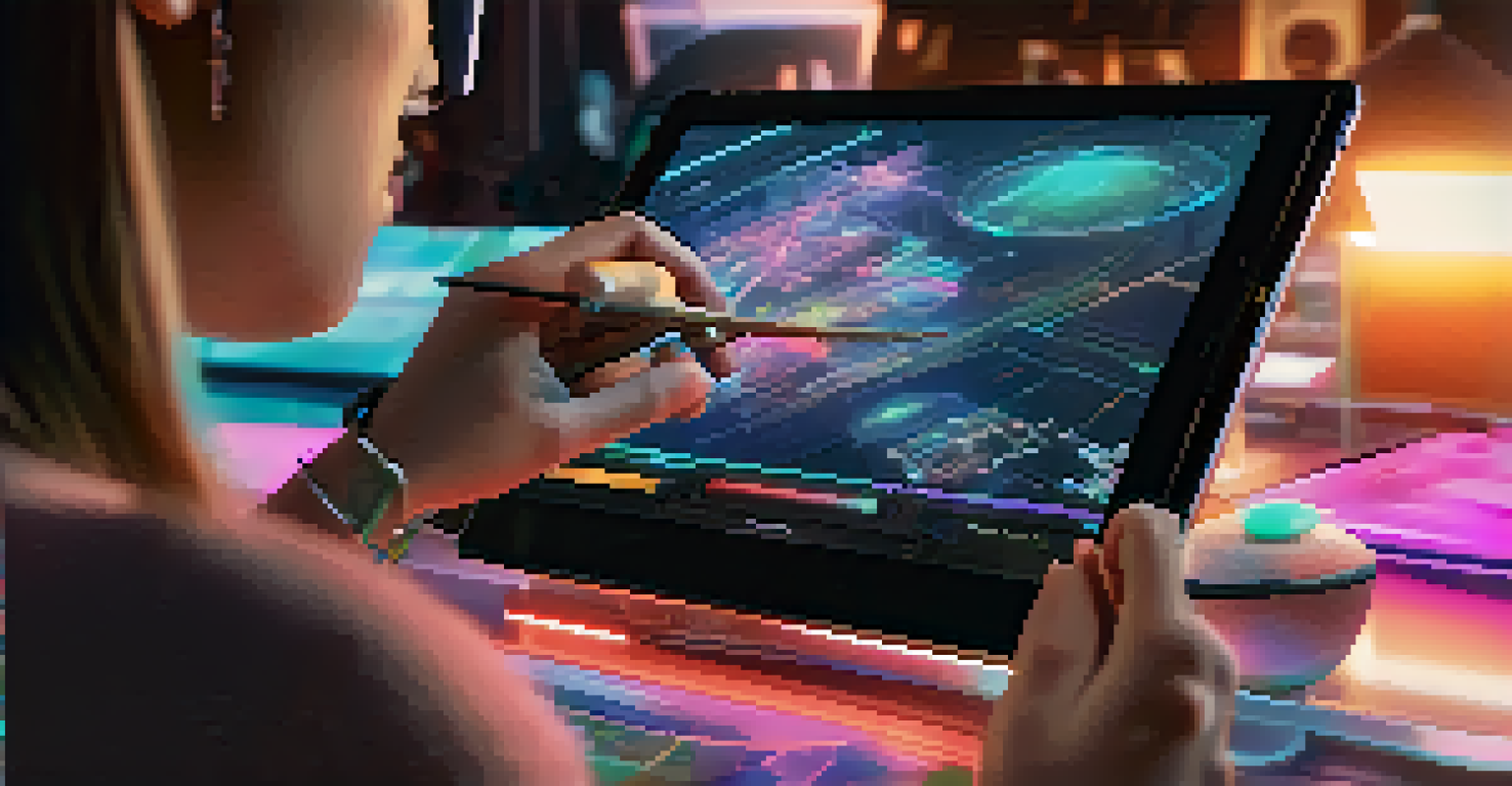The Evolution of Virtual Economies: NFTs and Digital Ownership

Understanding Virtual Economies: Foundations and Growth
Virtual economies have been around for decades, evolving alongside the internet. Initially, they were simple in-game currencies used for trading virtual goods, often limited to specific games. However, as online gaming and social platforms expanded, these economies grew more complex, allowing users to earn, trade, and spend real money on digital assets.
The future of ownership is digital, and NFTs are leading the charge.
One key factor in this evolution is the rise of multiplayer online games, where players began to see the value in rare items and skins. This shift sparked a burgeoning market where real-world money was exchanged for digital goods, leading to the creation of secondary markets. As these economies flourished, the need for secure and verifiable ownership became increasingly important.
This paved the way for blockchain technology, which introduced a level of transparency and security previously unattainable in virtual marketplaces. With the ability to prove ownership through decentralized ledgers, players could finally claim true ownership of their digital assets, setting the stage for the next wave of innovation: non-fungible tokens (NFTs).
What Are NFTs? A Simple Breakdown
Non-fungible tokens, or NFTs, are unique digital assets verified using blockchain technology. Unlike cryptocurrencies such as Bitcoin, which are interchangeable, NFTs represent one-of-a-kind items, making them perfect for digital art, music, and even virtual real estate. Each NFT contains distinct information that sets it apart from others, ensuring its uniqueness and ownership.

Imagine owning a limited edition print of your favorite artwork. Just like that physical piece, an NFT can signify ownership of a digital artwork, providing the buyer with proof that they own the original version. This uniqueness is one of the key selling points of NFTs, appealing to collectors and investors alike.
NFTs Redefine Digital Ownership
Non-fungible tokens (NFTs) represent unique digital assets, enabling secure ownership and trading in virtual economies.
NFTs have gained immense popularity, but their appeal extends beyond just digital art. Musicians, game developers, and even sports leagues are using NFTs to create exclusive content and experiences, further blurring the lines between virtual and real-world ownership.
The Role of Blockchain in Digital Ownership
Blockchain technology is the backbone of NFTs, providing a secure and transparent way to verify ownership. Each transaction involving an NFT is recorded on a decentralized ledger, making it nearly impossible to forge or duplicate assets. This level of security is critical in building trust within virtual economies, especially as they continue to grow.
Blockchain technology is not just a trend; it's a revolution in how we perceive value and ownership.
Consider blockchain as a digital notary, ensuring that every transfer of ownership is documented and traceable. This not only protects buyers and sellers but also fosters a sense of community among users who can confidently trade assets without fear of fraud. The transparency that blockchain offers is a significant reason why NFTs have gained traction so quickly.
As more industries adopt blockchain for their digital ownership needs, we’re likely to see even greater innovation. Whether it’s in gaming, art, or fashion, the implications of secure digital ownership are vast and exciting, paving the way for a future where virtual economies thrive.
Real-World Examples of NFTs in Action
Several high-profile NFT projects have showcased the potential of digital ownership, with notable examples including Beeple's 'Everydays: The First 5000 Days', which sold for a staggering $69 million. This sale not only highlighted the value of digital art but also demonstrated that NFTs can fetch prices comparable to traditional art pieces.
In the gaming world, platforms like Axie Infinity have created economies where players can earn money by breeding and battling digital creatures. Players can buy, sell, and trade these creatures as NFTs, effectively transforming gaming into a lucrative business model for many. This shift has attracted a diverse audience, from casual gamers to serious investors.
Blockchain Ensures Security
Blockchain technology underpins NFTs, providing a transparent and secure method for verifying ownership and transactions.
Sports leagues are also jumping on the NFT bandwagon, with the NBA's Top Shot allowing fans to buy, sell, and trade officially licensed highlights as digital collectibles. These examples illustrate how NFTs are not just a passing trend; they represent a fundamental change in how we perceive and engage with digital ownership.
Challenges Facing NFTs and Virtual Economies
Despite their rapid growth, NFTs and virtual economies face several challenges that could impact their long-term viability. One major concern is the environmental impact of blockchain technology, particularly the energy consumption associated with mining cryptocurrencies. As awareness of climate change grows, many are questioning the sustainability of NFT marketplaces.
Additionally, the speculative nature of NFTs can lead to market volatility, with prices often driven by hype rather than intrinsic value. This can create a bubble-like environment where new investors may find themselves facing significant losses. Education and transparency are crucial in helping potential buyers navigate this complex landscape and make informed decisions.
Regulatory issues also loom on the horizon, as governments and financial institutions begin to scrutinize the burgeoning NFT market. Navigating these challenges will be vital for the future of virtual economies and ensuring they develop in a responsible and sustainable manner.
The Future of Digital Ownership and NFTs
As we look ahead, the future of digital ownership appears bright, with NFTs likely to play a central role in shaping how we interact with virtual assets. Innovations in technology and an increasing acceptance of digital ownership will continue to drive interest and investment in virtual economies. We may see new applications for NFTs across various industries, expanding their use beyond art and gaming.
Imagine a world where you can purchase a digital home that exists in a virtual reality space, complete with unique furnishings and decorations—each represented as an NFT. Such possibilities could redefine ownership and investment, creating entirely new markets that blend the physical and digital realms.
Challenges Ahead for NFTs
Despite their growth, NFTs face challenges such as environmental concerns and market volatility that could impact their future.
Ultimately, as more people recognize the value of digital assets, we can expect the NFT landscape to evolve further. Collaboration between artists, developers, and consumers will be key to unlocking the full potential of NFTs and creating a more vibrant and inclusive virtual economy.
Conclusion: Embracing the New Era of Virtual Economies
The evolution of virtual economies and the rise of NFTs signify a transformative shift in how we perceive ownership and value in the digital age. By harnessing blockchain technology, virtual economies are becoming more secure, transparent, and accessible for users around the globe. This new era invites us to rethink our relationship with digital assets and how we engage with them.
As we embrace this change, it's essential to remain informed about the challenges and opportunities that lie ahead. By fostering a culture of transparency, education, and innovation, we can create a thriving ecosystem that benefits all participants in the virtual economy.

In conclusion, the journey of NFTs and digital ownership is just beginning. As we explore the potential of these technologies, we invite you to join us in shaping the future of virtual economies, where creativity and ownership thrive in harmony.